Truth and Beauty: The Hidden World of Symmetry
On the face of it, symmetry may seem simple, but diving beneath the surface reveals a whole new world. Over the last 100 years, the mathematical idea of symmetry has proved to be a guiding light for the world of physics. But what does a mathematician mean by symmetry? How does this link in with the world around us? And could it be the key to the mysterious 'Theory of Everything'? Plus, in the news, a new MRI-based cancer treatment, zero-emission highways and the curious case of Whistled Turkish.
In this episode
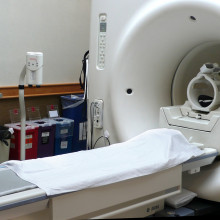
00:51 - New MRI cancer treatment unveiled
New MRI cancer treatment unveiled
with Dr Aneurin Kennerly, University of Sheffield
When it comes to targeting cancer in the body, one of the biggest challenges is delivering drugs directly to tumours, killing cancer cells efficiently while avoiding damage to healthy tissue which causes side effects. Now, a new study reveals a novel way to guide immune cells loaded with cancer-killing viruses into tumours using the power of an MRI, or magnetic resonance imaging, scanner. Aneurin Kennerly told Kat Arney how the new technique came about...
Aneurin - There are viruses that have been designed that can actively attack tumour cells. One of the biggest problems is getting them to the tumour itself. Obviously, our bodies are going to fight viruses and if you just inject them, the body will naturally fight the virus away. But what you can do is you can carry them inside a macrophage or a white blood cell that is inherent to your body anyway and so, will that pass freely and it's kind of a Trojan horse therapy it's been known as before. The problem with this is that if you just do this naturally about - so say, I inject a few million white blood cells that have our cancer treatment in them, only 5 per cent of them will ever reach a tumour site.
The initial ideas here were that you would magnetise the white blood cells and then if you place the magnet, a small external magnet over the tumour then the white blood cells, as they float around the body, the iron within them would be attracted to the little external magnet and therefore, they would stay in the region of the tumour. The only problem with this technique is that it's only useful for kind of superficial tumours, that is on the skin, and they can really be easily removable with surgery anyway. What happens if the tumours are deeper within the body? And that's where the MRI system comes in. It's a giant magnet itself and we can actually localise the field using the imaging gradients so we can start to target tumours deep within the body.
Kat - So, how do you make these cancer killing cells magnetic?
Aneurin - So, we place into the white blood cells, tiny little iron particles that are already used as MR contrast agents around the world and they just contain tiny little iron particles and as we all know, iron is very magnetic. So, that's the beauty of the research that we've been doing. The actual magnets exists in every hospital in the world. They're used every day in diagnosis. It's exactly the same hardware. We did not change the hardware in any respect. So, this can just be an application of that hardware in a new way.
Kat - I guess, marrying this kind of tumour targeting treatment in an MRI scanner, you can see what's going on at the same time as well.
Aneurin - Yeah, that's the real beauty of the technique. As well as targeting the therapy to the tumour, we can look at the development of the tumour over time in a traditional way that we would use MRI anyway. So, let's say our patient has to sit in the MRI scanner for an extra 10 minutes while their therapy is induced and that's the real benefit of the technique that MRI is already being used to assess whether tumours are in your body. If we can find them, if the radiologist can find them, then he will know where to target to.
Kat - How have you tested it so far?
Aneurin - At the moment, the current study is concerning prostate cancer. Prostate cancer was induced within our mouse model and we also looked at the metastases into the lungs so we've directed the therapy towards the lungs in some cases and looked at whether it reduced the metastases of the prostate cancer.
Kat - How well does it actually work?
Aneurin - In the current study, we treated the animals with one section of magnetic resonance targeting and it lasted between 30 minutes and 1 hour for each animal. We noticed a marked reduction in tumour size over a 21-day period.
Kat - Where are we with this research? Is it the kind of thing that we could see in hospitals very soon?
Aneurin - So, the study we've done at the moment is a pre-clinical study. It was done in mice. A mouse is much smaller than a human. So, the forces that we can generate in our pre-clinical system, we may be able to generate in a human system and that would need more testing. We would also need to test kind of how long we need to do the targeting for and how often. So, probably about 3 to 5 years let's say, before we see clinical application of this and clinical testing.
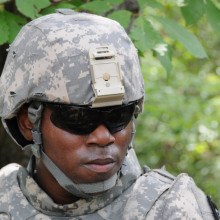
05:29 - Colourful polymers indicate injuries
Colourful polymers indicate injuries
with Professor Shu Yang, University of Pennsylvania
Head injuries have serious consequences, but it is often not realised how severe these injuries are at the time. After a bad accident, such as a rugby tackle gone 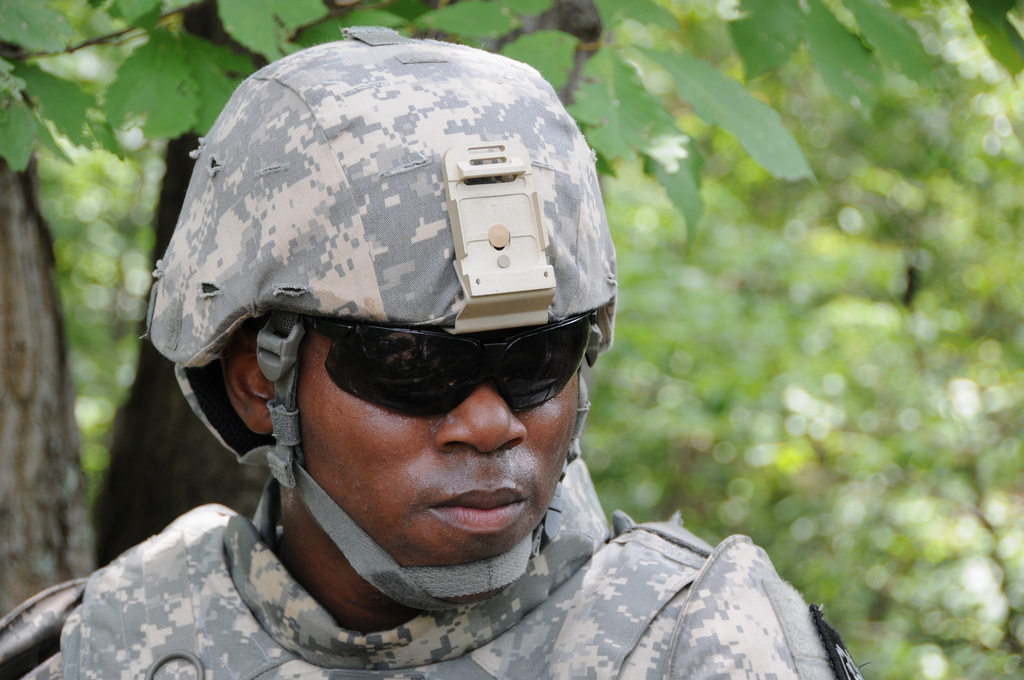 wrong or a bomb blast, symptoms might only appear later, after further damage has already been done. To get ahead of the problem, researchers have now developed a material that changes colour when a force is applied to it. If worn on a sports or army helmet, a change of colour would indicate how serious a head injury was, enabling appropriate action to be taken immediately. Professor Shu Yang at the University of Pennsylvania, who led the team, explained more to Amy Goodfellow...
wrong or a bomb blast, symptoms might only appear later, after further damage has already been done. To get ahead of the problem, researchers have now developed a material that changes colour when a force is applied to it. If worn on a sports or army helmet, a change of colour would indicate how serious a head injury was, enabling appropriate action to be taken immediately. Professor Shu Yang at the University of Pennsylvania, who led the team, explained more to Amy Goodfellow...
ShuYang - If you think about athletes playing in the football field or the soldiers at a battleground, oftentimes, they get hit on the head or on the body. So, we want to be able to detect a force so the medic or any of the person, the coach, they can look at the material, see the colour change then they can say whether this person, the head has been hit by a force which is too strong.
Graihagh - So, you could use this material in a sports field or in a battlefield to have on the helmet of a person and this will enable us to know if they've been hit on the head, how hard they've been hit?
Shu Yang - Yes, exactly.
Graihagh - When you apply a force to the plastic by squishing it for example, the underlying structure of the material changes. Just like when you squash a bit of paper in your hand, it deforms except as this plastic deforms, the change in structure means it reflects light differently thus changing the colour. Even better, you can choose a colour scheme. I like the idea of a traffic light system. A hard impact would cause your helmet to go bright red whereas green would mean you could play on.
Shu Yang - And so, once the whole size and shape is changed and light will be reflected differently. So, that's why the colour is being changed.
Graihagh - There have been materials made like this before, but what's different about yours. Why is yours special?
Shu Yang - Other people have also made inverse opals. So typically, they made a very squishy soft gel like rubbery materials or hydrogels. In this case, it's like you're putting a finger onto a rubber, so you deform the structure. Once you removed the finger, the rubber will bounce back. So, in this case, you won't be able to record the colour because the colour immediately returns to the original state.
Graihagh - Your material works at the right kind of forces that we would experience in a sports or military application.
Shu Yang - Exactly.
Graihagh - You seem to have gotten this material quite well worked out. How long will it take to get this into a commercial application until we start seeing this on the shelves?
Shu Yang - I think the material itself, the fabrication of the mature is well established. What I think is the need for further research and development is correlating this deformation or colour change to real brain injury. So, that's a long way to go, to demonstrate how we're actually using those materials to indicate how much damage the brain has received.
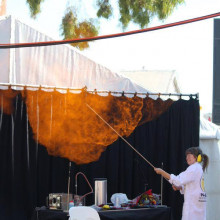
08:51 - Australia launches national science week
Australia launches national science week
with Christine Allen, Scitech
Getting the next generation involved in science is a challenge across the world, and this week Western Australia launched National Science Week with Perth  Science Festival. The Naked Scientists rocked up to blow up a few hydrogen balloons, but also to have a look around. Georgia Mills caught up with one of the lead organisers - Christine Allen, Executive Officer for National Science Week...
Science Festival. The Naked Scientists rocked up to blow up a few hydrogen balloons, but also to have a look around. Georgia Mills caught up with one of the lead organisers - Christine Allen, Executive Officer for National Science Week...
Christine - National Science Week is a celebration of science and a showcase of the best of science across Australia for a week.
Georgia - What are you hoping to achieve with this festival?
Christine - I was wanting to get people out and about, and hearing about science in their everyday life and also, seeing the explosive science, exciting science, and get people excited about science. I think getting scientists out from their labs and talking to the public is a really important thing.
So, that's what we've got going on today because they're often doing things that have to do with our health or with our future, and technology. We have no idea about them because they're always very busy doing other things - publishing papers, and doing their own science.
Getting out and communicating science is sometimes a low priority. So, this week is a real - and particularly, this weekend is a perfect opportunity for scientists to come out and talk about their science and why we need to fund science in general and technology and putting lots of resources into that sort of thing.
Kirsten - My name is Kirsten and I work for the International Centre for Radio Astronomy Research here in Perth.
Georgia - What are you guys doing here?
Kirsten - We're doing a lot of things, but my favourite thing we're doing is we're building stargazers with the kids.
Georgia - Can I have a look at one?
Kirsten - Yes, of course. Come over here. So, I have here a tube and it's basically like a normal poster tube that you use to put posters in the mail and we've got some black cardboard over the end of it, and then we've put holes to make a constellation. So, this one is Orion. If I hold it up to my eye and I look up at the sky, I can see Orion.
Georgia - Right. So, at the end of the tube, someone has pierced a lot of holes. Two of them are red in the shape - is that the shape of Orion?
Kirsten - Yes, that's Orion. So, we've also got cellophane that we can put over the end and make some of the stars' different colours. So, this is inaccurate in terms of where the colours are. Someone has just decided they want to make those ones red. But we do have accuracy in the colours. So, we don't have any green because there are no green stars - there's only blue, yellow, red and white stars. The blue ones are the hottest, the red ones are the coldest.
Georgia - What's the aim of this, getting kids poking holes in tubes?
Kirsten - So, it's to teach them about constellations and the patterns of the stars that we use in astronomy to understand the sky. Also, we give them a map of the sky, a planisphere, so they can go home tonight and have a look at the real constellation in the sky, and get an idea of what's above them and what astronomy is all about. We're hoping to really spark that joy and love of looking at the sky and understanding the world around them so maybe they'll learn more about science later on, and maybe consider a career in it.
Georgia - While most of the stalls there were aimed at getting people interested in science. Some of them were trying to get people to do science. One such stall was trying to get people involved in something called the Microblitz project. I spoke to Professor Andrew Whiteley to find out more.
Andrew - We're trying to recruit the general public to take samples of sulphurs around the state of WA. This is different to the way normal science works because usually, obviously, scientists will go out themselves and sample. But the WA size is so big, about 22 times the size of the United Kingdom. We actually encourage its citizens to actually go and take the samples for us.
The reasons why we're doing it? We actually want to look at what's out there in terms of microbial life, where what we call microbe ecologists. Microbes are really important in the way the earth works. The agricultural production is heavily involved with microbes, rehabilitation, and generally, answers biodiversity question - what microbes are out there and where are they? We don't really know the answers to these questions yet.
So essentially, it's about doing a state-wide survey, looking for these key pockets of microbial activity. Are there good microbes out there? They're associated with say, really productive agriculture. Are there bad microbes as well? Are there areas that we could improve based on a microbial map?
Georgia - And how are you getting people involved in this? How are you getting them on your team?
Andrew - Well for example like today, we're actually at the National Science Week here in Perth and we basically have a stand and it's like a recruitment drive. So, people come up and we talk to them about citizen science and there's a real interest in Western Australia about preserving the environment and really find out what's out there.
Australians have a real go-getting spirit and actually, just generally interested in the environment so such quite easy to recruit the citizen scientists. So, we talk to them about the project, we give them jelly snakes which is always a good enticement and also, today's world, we're doing a DNA extraction practical so the kids can come along and actually sign up for the project and do some extractions from strawberries of DNA. We bought 150 this morning, I think we've already ran out in about 3 hours.
The kids are having a great time. They've seen actually what DNA actually looks like. There's clear issues with kids coming through science and actually taken on as a future career. So, this is a real good way of actually engaging them at a very young age and actually, teaching them about science and about the real world, and their natural environment, and that there are great careers and opportunities in it.
Female - So, if you guys wait just a little bit, you will get some bit. You will get some sort of fluffy stuff and that's the DNA that should be appearing. You just have to wait a couple of minutes.
Male - Yeah, don't stir it.
Female - Don't stir it.
Female - Don't mix it up too much. There you go.
Georgia - What's your name?
Tilly - Tilly.
Georgia - Hi, Tilly. What are you doing here today?
Tilly - Looking at science stuff.
Georgia - Are you having fun?
Tilly - Yeah.
Georgia - What have you been doing on this stall? This looks really interesting. There's tubes of what looks like strawberry jam. What have you been looking at with this?
Tilly - It's strawberries that we're looking at their DNA and it's been put on my hand, and it's been disappearing onto my hand.
Georgia - Wow and why have you been looking at the DNA?
Tilly - Because it's cool.
Male - I think science is cool because you could like make some stuff and you could have some fun because I remember going to Scitech, this lady said, science, the best thing about it is that you could also have fun with that things you build.

14:58 - Google delays DIY smartphone initiative
Google delays DIY smartphone initiative
with Peter Cowley, tech investor
In the last 7 days, Google have announced that they have been forced to delay their open-source, modular phone - called Project ARA - until 2016 due to issues in its development. This is one of the first phones of its kind, but what exactly do we mean by 'open-source' and 'modular'? Are these ideas which we can expect to hear more of in the future? Graihagh Jackson spoke to Peter Cowley to find out more...
its development. This is one of the first phones of its kind, but what exactly do we mean by 'open-source' and 'modular'? Are these ideas which we can expect to hear more of in the future? Graihagh Jackson spoke to Peter Cowley to find out more...
Peter - Open source is the concept of, nobody owning the development or design and many people contributing to it. It's something that actually was around about 120 years ago when the car industry put together their patents and allowed everybody to use it. We've probably heard about source software. UNIX is an open source software platform which is used in many smartphones, but other things that you may not know are open source, Wikipedia, some pharmaceuticals companies have opened up drug designs to be open source. Scientific journals are becoming open source and rather very controversially is an open source 3D printed gun.
Graihagh - Wow, okay. What about modular? What do we mean when we say 'modular'?
Peter - Modular in the terms of the phone is that the back plate of the phone allows a number of different modules to be put on there which would be the processor, the memory, the cameras, the battery, other things such as medical technology, different forms of speaker perhaps, a better speaker, two speakers, three speakers, all together on this back plate.
Graihagh - Okay, I see. Google's project ARA has combined both of these two elements together to make this all singing all dancing phone.
Peter - Exactly, yes. Well, within the constraints of the size of the phone. What they've done is to have something which they call an endoskeleton which is basically a chunk of metal with some electronics in it which then allows the modules to be plugged in. The current standard for them is 8 modules on the back side which are things like the processor, etc. and two on the front. One of which of course is the screen itself. Putting these all together in a way that's going to be relatively cheap and robust and everything is obviously a very big task.
Graihagh - Why do we want modular phones? Why do I want to be able to take it apart and put it back together again?
Peter - Good question. In fact, the original idea behind it is not the modularity. It's to try and open up the smartphones to more of the globe. So, at the moment, the rough numbers are, there are 7 billion people on the planet. One billion have smartphones, 5 billion have feature phones - believe it or not - and only 1 billion don't have a phone. The idea was to move these 5 billion up to have smartphones which gives them more kinds of functionality, etc. The upsides are that you can upgrade your phone without having to throw something away which will use less waste.
Graihagh - So, if my battery started to get a bit rubbish...
Peter - Exactly or there's not enough memory, you don't have to replace your phone every 2 or 3 years or 4 years, so there's less wastage there. You can share modules so I could lend you my posh camera and you can lend me your speaker, etc. And also, people who make their own bits, but the downsides are, it will be a bit bigger because clearly, you've got this back plate in the middle of it. It will almost certainly be a bit more expensive which doesn't make much sense if you're trying to increase the numbers. The certification, this is again, making it work around the world will be cruelly complicated.
Graihagh - Because I suppose one of the big issues at the moment is, all these different phones and they all take different chargers and it's annoying and I'm also thinking about, I don't know, what happens if the back plate comes off too easily. But you want it to come off reasonably easily so you can change all the bits. So, I suppose there's lots of things to be balanced out here.
Peter - Yeah. So, the rumours over the last week or two were that they were having problems with the back plate. So, when you dropped it, all phones, they go through a drop test, vibration test, etc., and that these things were pinging out. They've got something really clever called an electro permanent magnet which effectively, you put a little bit of electric current in there and it's in one state, you put electrical current in again and it then unclicks itself.
Graihagh - Oh clever, so it's not like a button or anything like that.
Peter - No. Exactly, it just fits on there so, it's controlled by the software to release it or not. However, those rumours I think are wrong and it sounds like it's more like, there's a bit more work to do and they haven't actually released it yet. The most important thing though is whether there is really going to be a market, whether the price is right, whether it's just the early doctors and geeks will be buying it, or whether they didn't get the half a billion or a billion out there that's probably out soon.
Graihagh - Surely though over time, like with anything, it would just decrease in price as it becomes more available though.
Peter - It will, but If you take any form of manufacturing, if you can make something standard, all in one box, then you're more likely to produce it more cheaply if it's very standard. I mean yes, you're right. If you didn't have a camera on it, you didn't have a speaker on it maybe, which doesn't make any sense for a phone, then clearly, it would be a cheaper phone then.
Graihagh - Why has it been delayed?
Peter - It's been delayed either because of possibly these rumours that it doesn't withstand the drop test.
Graihagh - It's the back plate issue.
Peter - Yeah or it's because there's some other functions you want to look at.
Graihagh - I see. So, what's the future of this? Is everything suddenly going to become open source and modular? What can I expect to see?
Peter - Yes. There is a general move towards that. People are wanting personalised products, personalised presents, all kinds of things where you can adapt them yourself. As 3D printers come out of the business space, into the consumer space that will help as well. But there's a number of areas where open source is being used. There's an open source car, so you can build your own car using components, print your own components. There are drones, robots and a number of medical devices, so open source prosthetics. One of the ones that you might be interested is open sources houses. There's actually something called 'wikihouse' which is a set of plans which are open source, which people download, then print your own house which you then put together. So you can actually build a 4-bedroom house in about a week with two people.
Graihagh - Can I think of this like a flat pack house?
Peter - It does sound a bit like a certain Swedish company might be producing it, but that's not the case.
Graihagh - So, what's different about this? Is there like wires in the walls? Is everything sort of already built in or...?
Peter - No. The idea behind it is that you...
Graihagh - Literally, you can just put up within a week like you and I can do it.
Peter - Exactly, very easy to do and then you can modify the design, add windows where you want to do.
Graihagh - I suppose the other benefit of this is that by lots of more people using all these bits of technology and designing things themselves actually encouraging them to learn more things about it and get into technology and science subjects.
Peter - At the moment, there's a big strangled hold particularly with mobile phones with the 5 to 10 big manufacturers. That will release that strangled hold potentially by opening it right up to smaller companies.
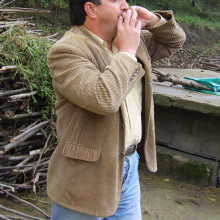
20:54 - Whistle while you talk
Whistle while you talk
with Professor Onur Gunturkun, Ruhr-University Bochum
If you ever find yourself wandering through the mountains of north-eastern Turkey, you might catch the sounds of Whistled Turkish floating on the breeze. 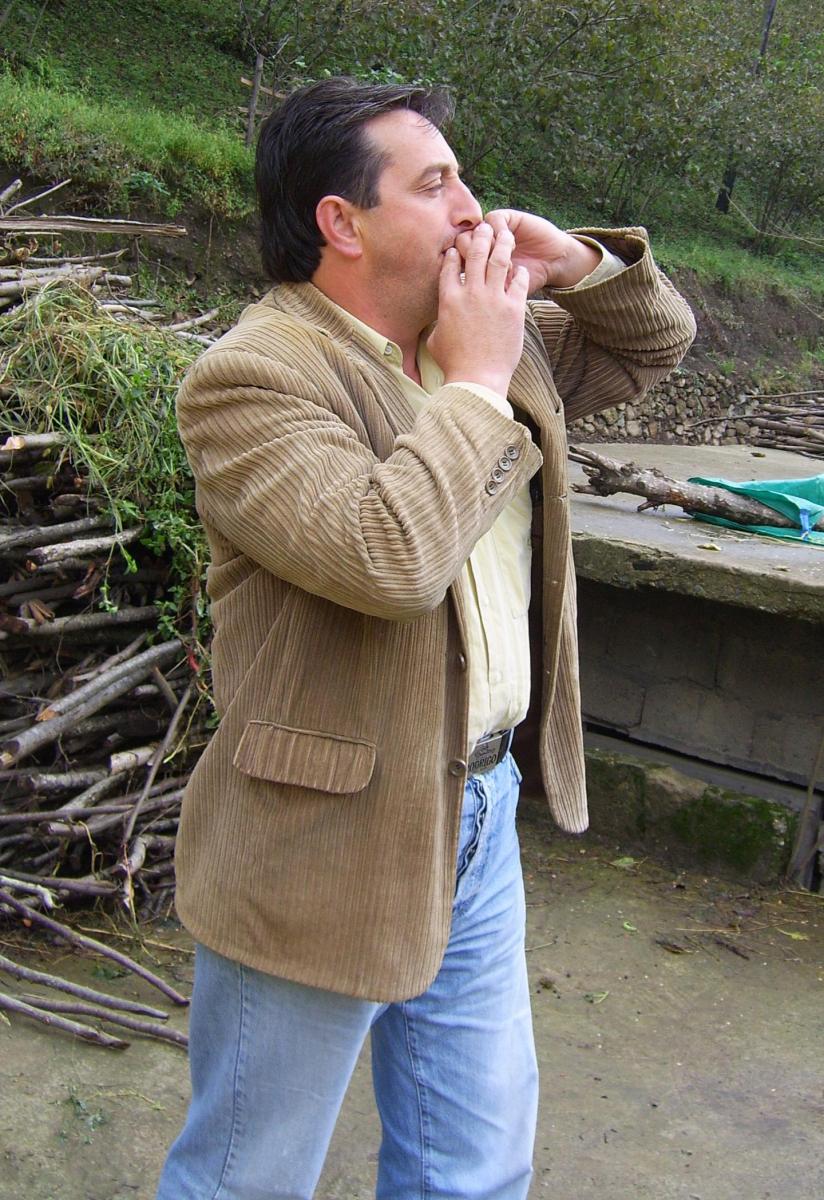 Whistled Turkish is a very unusual kind of language which is processed in similarly unusual ways. Onur Gunturkun spoke to Sam Mahaffey about how he's been investigating what makes it so special as a language...
Whistled Turkish is a very unusual kind of language which is processed in similarly unusual ways. Onur Gunturkun spoke to Sam Mahaffey about how he's been investigating what makes it so special as a language...
Onur - So, whistled Turkish is a way to communicate in mountainous regions. It only exists in tgenortheastern pocket of Turkey and it's used in a few villages. The interesting aspect of it is, that when you whistle, you can be heard in several kilometres away. But when you talk, you can obviously not be heard in that distance. So it means in mountainous regions, whistled Turkish is extremely handy to talk to neighbours that are on the other side of the mountain.
Sam - But whistled Turkish isn't a different language. It's just communicated in a different form. It's like how we can communicate English by speaking it or writing it, or how some people can communicate by using braille and sign language. Whistled Turkish has all the same grammar, words, and meaning as Onur's spoken Turkish. But like I don't understand braille...
Onur - I do not understand whistled Turkish. The physical change from spoken Turkish to whistled Turkish is so radical, so vast, that only after a while, if I knew the context, I could pick a few words, but that's it.
Sam - If native speakers can't understand Turkish in whistled form, can you tell that they're the same language? Let's try. If I wanted to ask for 1 kilogram of tomatoes in Turkish, I'd say...
Onur - Bir kilo domates lütfen.
Sam - Which in whistled Turkish would be:
[Whistled Turkish]
Sam - I could say, "The Black Sea is beautiful"...
Onur - Karadeniz çok güzel.
[Whistled Turkish]
Sam - And how about, "We speak whistle language"...
Onur - Islik dili konusuyoruz.
[Whistled Turkish]
Sam - But Onur has found something extraordinary about whistled Turkish. Whereas other forms of language are processed in one side of the brain, usually the left, whistled Turkish uses both sides. This is because it uses melodic changes to convey meaning. A bit like how we use intonation to express emotion.
Onur - So, let's suppose you're calling up a friend in the evening and she says to you, "I'm so happy that you called me back" which may say, "Oh, I'm so happy that you called me back". It's the same words, it's the same syntax, but it has a completely different meaning. This emotional content tells us a lot about the deeper meaning of a sentence. This is encoded in what is called the melodic line, slow changes of the acoustic signal over time. Now, whistles are exactly that - slow changes of the acoustic signal over time - and this is the specialty of our right hemisphere. So, whistle language should be encoded and processed by the right hemisphere.
Sam - If the right hemisphere processes melodic changes, does it also process tonal languages like Mandarin Chinese? Apparently, not. In Mandarin, different intonation of syllables can convey totally different meanings. But scientific studies have shown that the left hemisphere is still dominant over the right. Onur thinks that this could be because of how fast these intonations occur.
Onur - Possibly, still tonal languages have too many fast changes of the auditory signal. And so, they fall into the mechanisms the left hemisphere. There is no other language to my knowledge except whistle language that has these very slow modulations over time.
Sam - These slow modulations are closer to singing than to tonal language. In singing, the melodic line varies over a whole phrase, making it better suited to the mechanisms of the right side of the brain.
Onur - The right hemisphere has a certain kind of superiority for the analysis of song and music, and rhythm in general. So that for example, people with the left hemispheric stroke who have major trouble to speak, can sing and they also sing with words. So there, we see that the right hemisphere has a contribution under certain circumstances.
Sam - Dr Güntürkün hopes that one day, his findings will help in developing treatments for conditions affecting language.
Onur - Well, that would be my dream. Suppose, we would have a patient from Kuşköy, one of these villages where people use this whistled language, and this patient would, let's say, have a left hemispheric stroke and would be unable to properly understand Turkish in its spoken form. With this patient, suddenly understand more about what the other people say, when we would deliver it in a whistled form, that could be an alternative route to language understanding.
Sam - And so, Onur Güntürkün, many thanks...
[Whistled Turkish]

26:50 - The sex appeal of symmetry
The sex appeal of symmetry
with Professor Ben Jones, University of Glasgow
We're often told that facial symmetry is what makes us attractive, but why is it that symmetry has such an appeal to us? Do we seem to seek it out even if it's  not there? And if so, could it mean our assumptions and theories in physics are wrong? Graihagh Jackson spoke to Ben Jones from the University Glasgow, who explained just how he's investigated our attraction to symmetry...
not there? And if so, could it mean our assumptions and theories in physics are wrong? Graihagh Jackson spoke to Ben Jones from the University Glasgow, who explained just how he's investigated our attraction to symmetry...
Ben - There's really kind of two different types of studies that people have done to look at the relationship between symmetry and facial attractiveness.
There are studies where people have measured symmetry in faces and had those faces rated for attractiveness. In those kinds of studies, you tend to see a positive correlation.So, more symmetric faces tend to be more attractive. But it's really quite a kind of weak relationship.
But when you take a photograph of a person's face and then, using computer graphic techniques, manipulate it to be more symmetric, then you start to see slightly larger effects in symmetry, so making a face more symmetric tends to make it look more attractive. If you take an individual face and then kind of exaggerate the naturally occurring asymmetries in it, it very quickly becomes unattractive and even can become really quite sort of bizarre and freakish-looking.
Graihagh - Bizarre and freakish-looking? I had a barbecue last night and decided to conduct my own analysis by showing my friends three pictures of one girl. In one, the image had been manipulated to look extremely asymmetrical. We call this number one. Picture number two is what what we might consider a normal face - a few asymmetries here and there and number three was completely symmetrical. They of course, had no idea why I was showing them three pictures of the same person and it caused considerable debate when I asked them which one was the most attractive.
Female - They're the same. They're just slightly different.
Male - They've got a different crinkle in them because of the paper.
Graihagh - No, that was just my bad folding in my backpack.
Female - They have like, re spaced the eyes haven't they. I can't tell.
Male - I'd say middle.
Female - Yeah, I'd say middle.
Graihagh - You say middle is most attractive?
Female - The more I look at it, 3 is becoming more attractive.
Female - I think 3 is more attractive.
Graihagh - Three is more attractive?
Female - Her eye's wonky on the side. There's a bigger space.
Male - One is nowhere near it.
Graihagh - So, one is the least attractive. We're agreed on this and there's more leaning towards 3?
Female - I think 3 looks like she's got bags.
Male - I'd like to say 3 is the least attractive.
Female - Yeah, I'm going with 1.
Female - The more I look at it, the more I go to this one.
Graihagh - How many for number one?
Male - I don't like the mouth on this one it's a bit frowned down.
Male - I'm going for number one.
Graihagh - So, you're for number one?
Male - Yeah, I've got to now. I've got to say one. Yeah, I'll go with one.
Graihagh - Who is for number two? So, we've got three for number two. You're going to go for number three. You've completely disproved all the science.
Female - What's the science?
Graihagh - So, the idea is, are we bias to seeing symmetry because we find symmetry more attractive? This is the most symmetrical one.
Female - So, I've got the perfect face.
Graihagh - This is extremely asymmetric.
Male - I've drunk a lot of alcohol today.
(Laughter)
Female - My eyes are wonky anyway.
Graihagh - I think maybe, we can rule this down to the fact that I've creased the paper too much in my backpack.
Female - Yeah, it's a shame it goes right through her face.
Female - Yeah, and we're doing it in the dark.
Graihagh - Okay, so I'm not entirely sure what we can conclude from that extremely scientific investigation. But overall, my friends did seem to think that the asymmetrical face was the least attractive, but why is symmetry so sexy.Ben Jones again.
Ben - Well, it's kind of quite a controversial issue and there's a number of different theories that have been put forward. If you speak to cognitive psychologists, they'll tend to point to the fact that we kind of develop an internal prototype of faces based on all of the faces that we encounter. But that internal prototype which you can kind of think of as a mathematical average of all the faces that you encounter is likely to be perfectly symmetric because all of those individual asymmetries in the individual faces that we see will kind of average out. We know that faces that more closely resemble this prototype are easier to process and we might even like them more because they're easier to process. And it's that kind of processing bias that could contribute to the appeal of symmetric faces.
On the other hand, working from ideas about animal behaviour and particularly studies of meat preferences in non-human animals, other researchers have theorised that our attraction to symmetric individuals might be less to do with kind of processing biases and more to do with the type of qualities that symmetry might advertise about people. So, one idea is that more symmetric individuals might be healthier, they might be physically fitter, they might be physically stronger. And those are kind of characteristics that we find desirable in potential mates, and also in potential allies and associates.
Graihagh - I see and are we biased to then see symmetry elsewhere?
Ben - It's certainly the case that symmetry isn't just attractive in faces. There's quite good evidence now that symmetry tends to be preferred in abstract art, at least among non-professional art critics. And there's even evidence that symmetry might be attractive in things that you can't even necessarily see. So for example, although when we think about symmetry predicting attractiveness in humans, we tend to think about symmetry of bodies, and symmetry of faces. But actually, the voices and even the body odours of symmetric people tend to be more attractive than those of relatively asymmetric individuals. And that kind of ties back again to this idea of symmetry perhaps being attractive because it advertises something about our underlying physical qualities.

33:12 - What is symmetry?
What is symmetry?
with Professor Mark Ronan, UCL
Symmetry is something that we're all very familiar with, whether it's checking that eyeliner is even, making sure photos are blu-tacked straight on the wall or even  just noticing the symmetry of butterflies' wings. However, there's much more to symmetry than meets the eye, and it has formed the mathematical backbone for all of our modern physical theories. But what does symmetry mean to a mathematician? Kat Arney spoke to Mark Ronan to find out more...
just noticing the symmetry of butterflies' wings. However, there's much more to symmetry than meets the eye, and it has formed the mathematical backbone for all of our modern physical theories. But what does symmetry mean to a mathematician? Kat Arney spoke to Mark Ronan to find out more...
Kat - So, as a mathematician, how do you see symmetry?
Mark - We come at it from different directions, but it can all be explained by taking an object like a square and looking at the different symmetries that it has.
Not just a left, right symmetry or a top, bottom symmetry, or a diagonal symmetry where you can reflect it across the diagonal, but there are actually 8 different symmetries for a square.
Kat - So, that means that you could say, put a mirror in the middle of it and it would still look like a square, or still look the same from all these kind of different angles.
Mark - That's right. And the whole idea is to take all of them together and that is what mathematician's call group.
Kat - So, that's a number of different kind of equal things, equal views of something.
Mark - Yes, you can look at it that way. The idea is that you can do one and then another one. The concept of a group is absolutely fundamental. That's what physicists use when they're talking about symmetry. They're really talking about a group of symmetries.
The word 'group' was originally introduced in French - it's got an 'e' on the end, but it's the same word - by Evariste Galois, a young mathematician who never reached his 21st birthday.
Kat - In terms of his contribution to maths and symmetry, what was Galois thinking of ?
Mark - What he was doing with mathematics was, he was trying to solve a problem about equations.
Kat - What was that problem?
Mark - The problem was how to distinguish equations that have solutions that you can extract in a relatively simple manner and equations that have solutions you can't extract in a simple manner.
Kat - So, these are kind of beautiful solvable equations and then more complicated, maybe insoluble equations.
Mark - A good word because actually, mathematicians use that world 'solvable'. They're solvable and other ones that aren't solvable in the same sense.
Kat - In terms of symmetry, which ones are the symmetrical ones?
Mark - The more symmetry they have, the harder they are to deal with.
Kat - So, is this because you kind of look at the equation and it all sort of balances out. They're all more equivalent, more symmetrical, and it's harder to pick out, "Okay, we can start here. This is an answer."
Mark - That's absolutely right. You can't quite grapple with the thing very well because everything looks the same from different multiple points of view.
Kat - A lot of what we talk about in physics is all based on equations, coming up with equations that describe the physical laws of nature. In terms of symmetry, how symmetrical are the equations that we have in physics?
Mark - Well, it's not so much actually solving equations. Symmetry produces patterns. Physicists study patterns of different elementary particles for example.
When I was a teenager, there was a whole zoo full of these things. They managed to create order out of it and they did it by using symmetry.
In fact, Herman Weyl who was a famous mathematician, also a very good physicist said, "Symmetry, as wide or narrow as you may define its meaning is one idea by which man, through the ages has tried to comprehend and create order, beauty and perfection."
But they came up with some very clever ideas using symmetry in a serious way. I don't just mean in a silly way.
Kat - In a sort of a matchy-matchy, this particle is the mirror image of this one.
Mark - It's not just mirror image. The symmetries were more complicated than that when they start to look at the standard model of physics at a very most basic level where you're looking inside an atom.
Kat - So broadly, when we're thinking about equations that govern the universe, govern how it works, should we expect them to ultimately have symmetry within them?
Mark - I think we probably expect some symmetry because if we don't have any symmetry at all, we're not going to make sense of things.
Physicists really demand a lot of symmetry in order to make their theories comprehensible.

38:15 - How does symmetry shape nature's laws?
How does symmetry shape nature's laws?
with Dr Daniel Baumann and Professor Andy Parker, University of Cambridge
All of our modern theories in physics are based on mathematical ideas of symmetry, including Einstein's famous ideas of relativity and the Standard Model!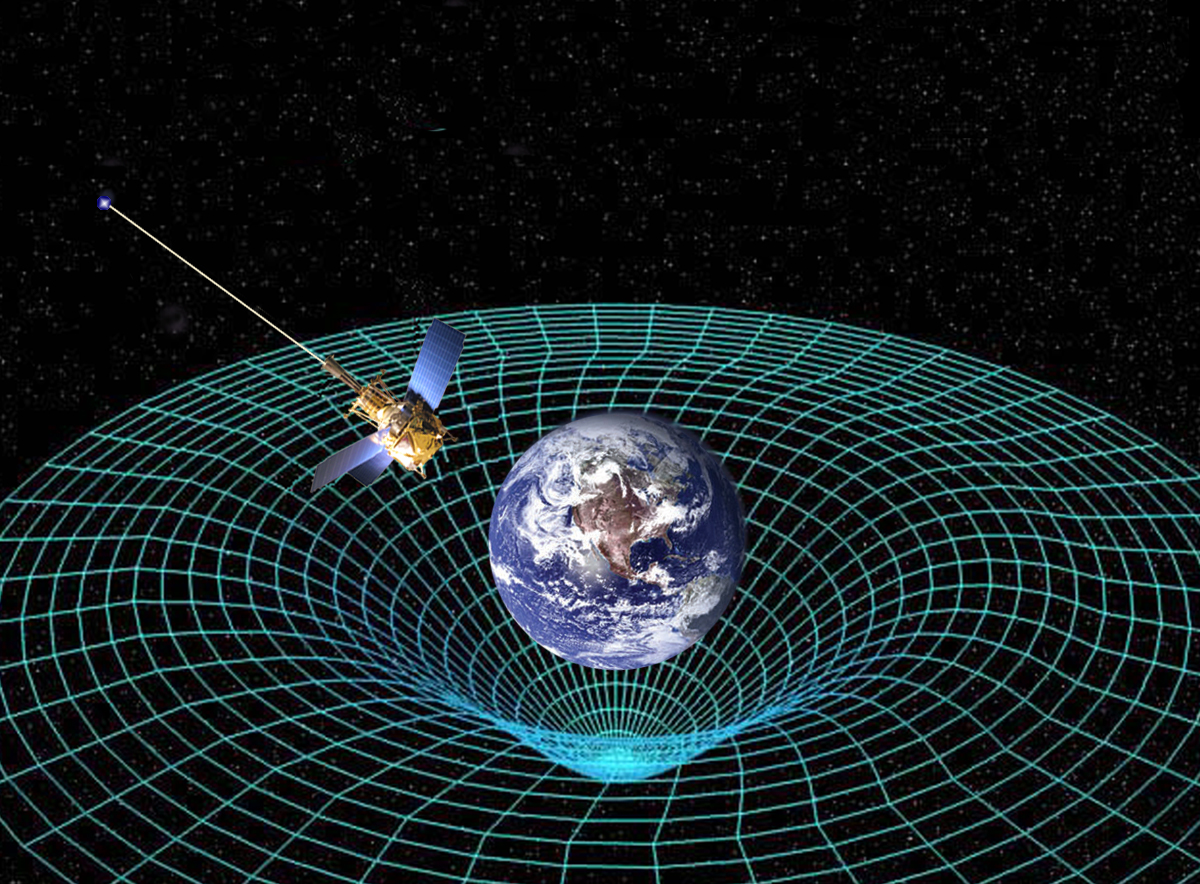 But how and why is this the case? James Farr dragged Graihagh Jackson out of the office with a tennis ball to explain...
But how and why is this the case? James Farr dragged Graihagh Jackson out of the office with a tennis ball to explain...
James - Einstein's theories completely revolutionised the way we think about gravity and they were all sparked off by a simple fact which Einstein noticed about the speed of light which we're going to think about now.
Graihagh - Okay, so what's this got to do with a tennis ball though?
James - Well, the normal way we think about speeds is they add up in a very simple way. To demonstrate this, if you can now go and stand about 10 meters or so away from me Graihagh...
Graihagh - Okay, about 10 meters.
James - If you can now throw the ball to me, not too hard of course.
Graihagh - Okay, I'm going to do an underarm throw. Ready?
James - Here we go. That took about a second to get to me. So, we can say it was traveling 10 meters per second. We both agree on that, right?
Graihagh - I'd say so, yeah.
James - So, if we do this again, this time, you're going to be running towards me as you throw the ball.
Graihagh - Okay, I'll give you my best cricketers throw. Okay, ready?
James - Go for it. That was much faster that time.
Graihagh - I'm sorry, James.
James - That's quite alright.
So, the ball was much faster because you were running as you threw the ball.
So, you can add the speed you are running at maybe 5 meters a second onto the speed you threw the ball at because you threw it just as hard as you did before.
So, we had 5 plus 10 to get about 15 meters a second. That's the overall speed of the ball relative to me. How did the speed of ball look relative to you?
Graihagh - Well, it didn't feel or look any different to me.
James - You threw the ball exactly as hard as you did before. So, it should be the same speed.
So here, we've got a demonstration of two different observers - me and you, Graihagh - observing the same ball but thinking that it's going at two different speeds.
Graihagh - Okay, so the movement of that ball is relative to us, you could say?
James - Exactly and that's what's so different about light. If you were firing a beam of light rather than throwing a ball, the little photons which make up the beam of light would all seem to be moving at exactly the same speed, both from my perspective and from yours even though you're moving relative to me.
Graihagh - Good to know, just in case I go throwing balls of light any time soon.
James - Balls of light aside. This idea that light must always appear to travel at the same speed no matter how fast and what direction we're traveling was Einstein's stroke of genius.
He realised this by looking at the symmetries in the equations that describe light as Daniel Bowman from the University of Cambridge explained...
Daniel - One way of noticing that there's something symmetric going on is to notice that there's something that's not changing.
If we look at the symmetric objects from different point of view they look the same, that's how we identify that an object symmetrical rather than arbitrary. And so here, there was also a hint that there was something that didn't change.
Two different observers moving relative to each other would agree on the speed of light. And so, underlying this, there's a hint that there's a symmetry that enforces this. And so, that symmetry is what's called Lorentz symmetry or Lorentz invariance.
James - These so-called Lorentz symmetries aren't actually too complicated. If you can imagine trying to measure the distance between two points on a piece of paper then no matter how much you rotate your piece of paper, that measurement will always stay the same, right?
It's sort of the same for light, in that the speed of light must always be the same for every observer which means that there must be some kind of underlying symmetry. But how do we know that this is true?
Daniel - To a theorist, you know it's true because it's too beautiful not to be in some sense. I think even Einstein once said, if an experiment came out that would disagree with his theory of relativity, both special and general, it's too bad for the experiment. There must be something wrong with the experiment because the theory itself is too beautiful to fail.
But of course, at a practical level, we do have now plenty of experiments that just show us that this is really what's happening.
James - How has this had an effect on physics?
Daniel - One way, especially for theorists, I think, it has demonstrated the power of pure thought in coming up with physical theories. So Einstein famously introduced these thought experiments, he asked himself, "What happens if I rush off the light ray or what happens to time when a clock is traveling on a fast moving train?" Things like that.
So, it's a very different way of doing physics, less driven by experimental data, but by just purity of thought. And symmetry is trying to see how the power of symmetry is actually restricted to types of physical laws which can be written down.
And so, this attitude of letting yourself be guided by symmetry has become vital. I think Einstein was one of the first. Of course, at a practical level, it has just permeated all of modern physics. A world without relativity to me is unimaginable.
James - We've heard about how symmetry is used in our theories of relativity which we use to describe gravity.
This is useful if we want to think about very big things like planets moving around the sun. But what if we want to zoom right in and look at much smaller things, maybe atoms?
I'm going to head across the road from the Institute of Astronomy where I'll get to the Cavendish Laboratories. Historically, these labs have played a very important role in the build- up to what we now call a standard model...
Andy - I'm Professor Andy Parker. I'm the head of the Cavendish Laboratory. So, the standard model is our current understanding of all the particles and forces between them that make up atoms or normal matter and indeed, everything in the universe.
So, we have quarks which are the constituents inside protons and neutrons, and therefore, make up the atomic nucleus and the bulk of the weight of the atom.
And then outside of that are electrons which circle the nucleus like little planets, and a bunch of other particles similar to electrons, and those two types of particles make up the matter in the standard model, and the forces between them make up the interactions.
James - However, the journey to this theory was by no means an easy ride.
Andy - When we first turned on large accelerators, we started to make new particles by colliding things and those new particles were coming out sometimes once a week, almost discovering what seem to be a new fundamental particle. And people were talking about a zoo of particles.
James - The trouble was, it wasn't what you might expect from a zoo. There was no plaque telling you which species was which and everything was mixed in together - lions with toucans, and kangaroos, all in one enclosure.
Scientists needed a way to categorise these new particles, a bit like a zoo has a reptile house and an aviary.
The standard model has helped us to do this using symmetry and more recently, the Higgs Boson - the particle which explains why things have mass.
Andy - In fact, the Large Hadron Collider which discovered the Higgs has just restarted and we're collecting data right now. With the LHC data, we should be able to perhaps discover something really exciting.

45:37 - One theory to rule them all
One theory to rule them all
with Professor Katherine Freese, Nordita
We currently have two very symmetrical theories - relativity and the Standard Model - but if we've managed to compress physics into two theories, then can we go further and squeeze it all into one theory to rule them all? In other words, can we construct a 'Theory of Everything'? Graihagh Jackson spoke to Katherine Freese from Nordita, who first explained what exactly we mean by a 'Theory of Everything'...
Katherine - Well, from a physicist's perspective, a theory of everything is one that would encompass all of the physical laws of nature. In today's universe, we know there are 4 separate forces.
Graihagh - When you say 4 forces, what are you referring to?
Katherine - Well, we have the most important ones of our everyday lives. There's the electromagnetic force which includes electricity and magnetism. Then we also have the strong force. This is actually where holds our nuclei together. Our nuclei have neutrons and protons in there and they don't fly apart because of the strong forces holding them together, so they're really necessary for our existence. We also have a third force - the weak force - which is responsible for many types of radioactivity. And then of course, there's gravity. So today in the universe, we have all these four different separate forces.
Graihagh - And then at the Big Bang, when the universe began, we thought all these forces were one force, one single thing.
Katherine - Well, as we go backwards in time, then we can watch them start to unify. So, we do know that electromagnetism and the weak interactions unified into one single force - electroweak - and then as you go farther back in time then you could also bring in, at least we think we can combine that with the strong interactions into what we call a grand unified force. If we could go even farther back in time, almost all the way back to the Big Bang, that's where gravity would join, if only we knew how to do that. That's what is really missing in our trying to build a theory of everything.
Graihagh - Why is that so tricky? Why can't we seem to unify? Is it just that we can't look that far back in time?
Katherine - Well, that's certainly part of it. On the theory side, there's a real stumbling block that - well, Einstein was already trying to get at it and we've made some progress, but the unification of gravity in general relativity, and then quantum mechanics. Unifying general relativity and quantum mechanics, we don't know how to do that. We do have some ideas if only we can make that work then we have some chance of approaching this theory of everything.
Graihagh - So in some sense, it's joining this quantum world - the tiny world - with a much bigger world - these theories of gravity and Einstein's theories of relativity.
Katherine - Yeah. The quantum world describes very well what's going on in atoms and then in the particles inside the atoms. It works on small scales. And general relativity, we know how to use it on the large scales of clusters of galaxies, galaxies, the earth and things like that. But combining these two has proven to be very, very tricky.
Graihagh - Just stepping back a bit, what has this got to do with symmetry?
Katherine - If we can in fact, unify everything in terms of a single theory then this would be a single symmetry, mathematically speaking, that would describe everything. So, we do know that's what happens when we write down grand unified theories or some of these higher symmetric states of the universe early on. But as the temperature of the universe drops then these symmetries break. It's called spontaneous symmetry breaking. So, what happens is, a single force splits off into the 4 different forces that we have today. So, that's a breaking of that symmetry that we had early on.
Graihagh - Aah ok, I'm with you now. Why do we really want to do this? Why do we need to look back to the Big Bang and before?
Katherine - Well, this is something that I think that everybody wants to know. How did the universe begin? What was the starting point? What is remarkable to me is how well we've done. The Big Bang happened 14 billion years ago and we have a pretty good understanding of everything that went on. We have predictions for things that would have taken place 3 minutes after the Big Bang and they're verified to incredible accuracy. But people, everybody is always asking, "But what happened before that? Let's go farther back in time." If only we had this theory of everything then we hope that will let us address some of these questions of what happened even earlier than that.
Graihagh - When can we see this theory to be announced? Is it likely to be soon?
Katherine - Well, I would say not in the next decade. I guess that's the fun of doing a research.We don't know how long it's going to take. There's a lot of physicists working on a really interesting idea - string theory - which does have the capacity to incorporate both quantum mechanics and general relativity. But the trouble is that it doesn't seem to make predictions that we can test. So, the way string theory works is that the most fundamental objects in the universe would be strings and these strings vibrate. Those vibrations are particles. So, one particular type of vibration would be an electron, a different type of vibration would be a proton. So, it's a beautiful mathematical theory and as yet, it is not making predictions that we can see at the Large Hadron Collider. So, the problem is, it's a mathematically beautiful thing, but we're kind of stuck experimentally.
Graihagh - Does that mean we will have completed the universe?
Katherine - Even if we do have a theory of everything, we still won't be finished. There's always a chance of looking further back in time. The more we know, there's always the more questions that appear. Humans are really creative people and we are explorers. It's fun. We want to go into the unknown. So, there will always be new questions for us to ask.
Graihagh - Why is it called the theory of everything then if it's not going to be describing everything?
Katherine - That's just a physicist's term for the unification of all the forces. Automatically, if you're unifying the forces, you're probably understanding what the universe is made of which right now, we don't. We only know 5 per cent of the total content of the universe - the ordinary atoms. We don't know the dark matter, we don't know the dark energy. So, when physicists use this term 'theory of everything', what they're referring to is the unification of the 4 forces and the understanding of the content of the universe.

52:21 - Why does music sound happy or sad?
Why does music sound happy or sad?
Amy - We, along with Sophia Pang on Facebook are anxiously waiting for an answer to this one. I was thinking of making a new Naked Scientists theme tune and I'd like it to be happy and exciting, not sad. Music psychologist Dr Andrea Schiavio is here to help. Firstly Andrea, is it true that music can make us feel in a certain way or is it just me being an emotional person?
Andrea - That's a very interesting question. Most people would agree that music makes us think certain things or feel certain feelings, but actually, not everyone would agree on how exactly these feelings are generated. Most importantly, it seems there is no way to prove that, what the question really implies, that there is a specific relationship between a certain type of musical chord in a certain emotion really occurs universally.
Amy - Okay, so there's a lot to take into account. Let's at the beginning then - what are we actually hearing when we listen to music?
Andrea - Well, unless we really want to focus on them, in our everyday musical experience, we do not really listen to chords as such. But rather, we listen to durations, dynamics, timbers, lyrics, and many other musical parameters. When we listen to someone talking to us for example, we do not really focus on the letters that make the words, but we rather rely on a broader context - the sentence, the gestures, the way we feel about that person and so forth.
Amy - Right. There's a whole host of things that we are hearing when we listen to music. But you mentioned earlier that there's no way to prove that what I would consider as sad note is what someone in, say, China would also consider to be sad. Why is this?
Andrea - Mainly because a clear distinction between major and minor keys only emerges within modern western musical system. It's not consistently adopted in other musical cultures and traditions. This is why a number of researchers now tend to consider enculturation as a good way to look at the issue.
Amy - Enculturation. What's that?
Andrea - Enculturation is basically where you learn an association between two unrelated concepts by constantly being exposed to that association. For example, we might link certain features of music such as a minor key to certain meaningful contexts like a funeral march. So, this means that we tend to develop relationships in our engagement with music within our own culture, leading to predictable emotional correlations and meanings.
Graihagh - So, it's a learned association that means we, here in the West at least, think minor keys sound more sad.
Andrea - Well, while our lifetime of listening experiences certainly plays an important role, it might be a bit over simplified to attribute our emotional experience of music solely to such learned association. Other theories for example found commonalities with emotional cues in language, arguing that as a sad speech, minor keys may sound sad because they tend to be less stable and have lower notes than normally expected. So, in the west at least, we do think of minor keys as sad and major keys as happy because we have learned to associate these sounds with sad or happy experiences including language and our interactions with others.
Amy - Hmm, so if people all across the world are listening to our Naked Scientists show, there might be no music that I could use for a new themed tune to make everyone feel happy and excited. Maybe let's just stick to the current tune then. Sam - Thanks Amy, I'm Sam Mahaffey and next week I'll be trying to answer a question that Llewellyn tweeted us:
Llewellyn - Why do we have toenails?









Comments
Add a comment